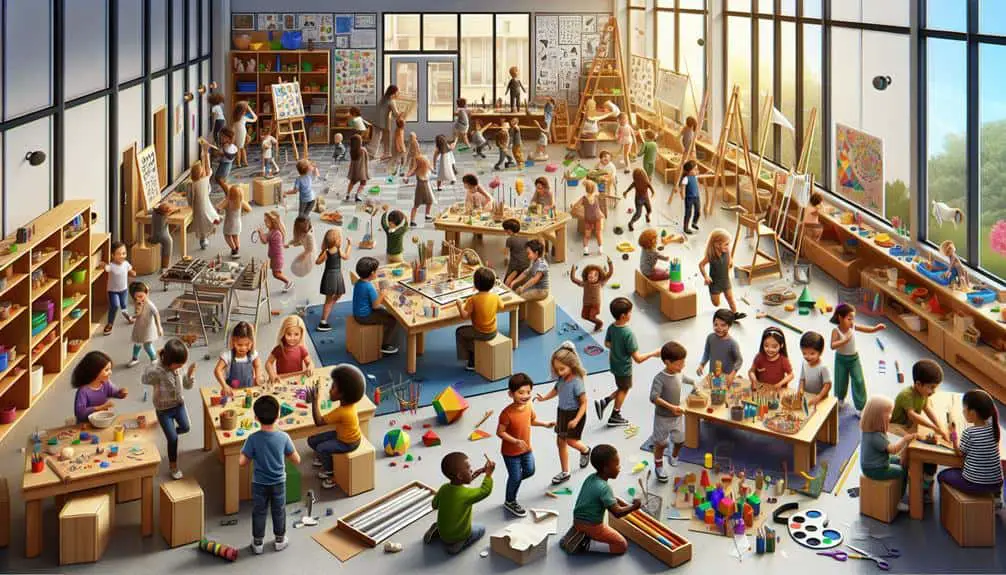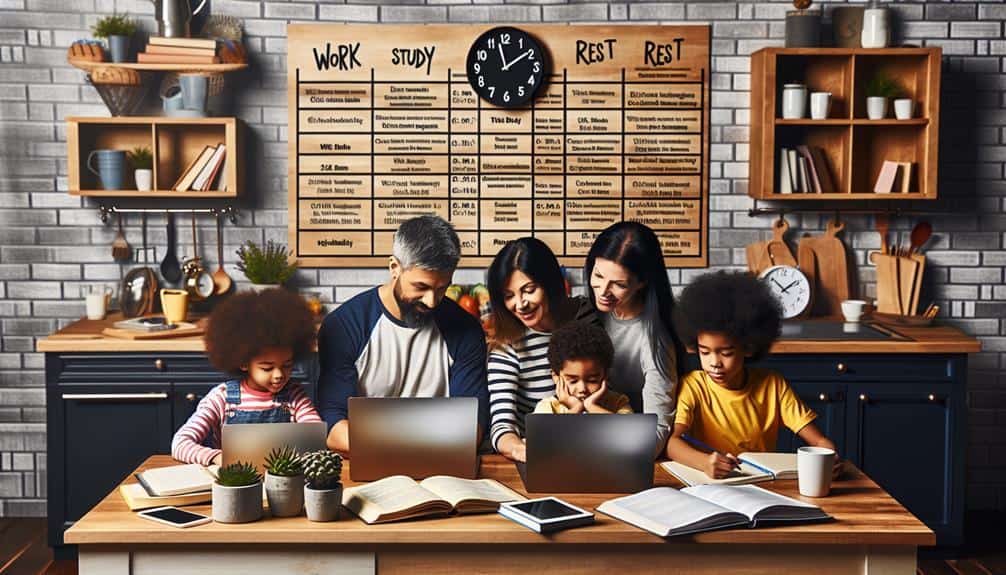For kinesthetic learners, maximizing homeschool schedules means including hands-on activities, movement breaks, and real-world experiences. Try tactile learning with projects involving clay and building blocks. Remember to schedule movement breaks to enhance focus and memory retention. Engage in practical projects like science experiments and art creation. Outdoor learning time can boost creativity and reduce stress, leading to better academic performance. Plan a mix of active and quiet activities to keep the schedule balanced for best learning. By incorporating these strategies, you can better cater to the needs of kinesthetic learners and enhance their homeschooling experience.
Key Points
- Schedule regular movement breaks for improved focus and learning retention.
- Plan outdoor activities to enhance engagement and creativity.
- Incorporate hands-on projects and experiments into the daily schedule.
- Utilize real-world applications for practical learning experiences.
- Create a structured routine with consistent outdoor learning time.
Understanding Kinesthetic Learners
To understand kinesthetic learners, it's important to recognize their learning preferences, which revolve around physical engagement and movement-based learning. Kinesthetic learners thrive when they can interact with their environment through hands-on activities and experiential learning. For them, sensory experiences play a vital role in processing information effectively. This means that traditional teaching methods mightn't be as effective for them compared to methods that incorporate movement and tactile experiences.
In a classroom setting, kinesthetic learners are often the ones who excel in activities like role-playing, building models, or conducting experiments. They prefer to learn by doing rather than just listening or reading. By engaging in physical activities, they're better able to retain information and understand concepts more deeply.
Kinesthetic learners benefit greatly from lessons that involve physical movement and practical applications, as these methods cater to their unique learning style and help them make meaningful connections between theory and practice.
Designing Practical Learning Activities
To cater to your kinesthetic learner, consider incorporating hands-on activities that engage their sense of touch and movement. Implementing movement breaks throughout the day can help them stay focused and retain information better.
Real-world applications of concepts learned can also make the material more relatable and enhance their understanding.
Hands-On Activities
How can you effectively design practical learning activities to engage kinesthetic learners in homeschooling schedules? To cater to kinesthetic learners, focus on hands-on activities that promote sensory experiences, interactive projects, tactile learning, and physical engagement. Incorporating these elements into your homeschooling schedule can enhance the learning experience for kinesthetic learners.
Design activities that allow for hands-on exploration and manipulation. For example, science experiments, art projects, and building activities provide opportunities for kinesthetic learners to engage with the material actively. Encourage the use of tangible materials like clay, building blocks, or interactive educational tools to stimulate their senses and promote learning through touch.
Create interactive projects that require movement and physical engagement. Incorporate activities that involve role-playing, simulated scenarios, or outdoor exploration to keep kinesthetic learners actively involved in the learning process. By designing practical learning activities that cater to their need for movement and physical interaction, you can effectively engage kinesthetic learners in your homeschooling schedule.
Movement Breaks
Engage kinesthetic learners in your homeschooling schedule by incorporating regular movement breaks that promote physical activity and stimulate cognitive function. These brain breaks are essential for maintaining focus and enhancing learning among individuals who thrive on movement and tactile experiences.
Integrate short bursts of physical activity into your routine to help kinesthetic learners better retain information and stay engaged throughout the day.
Movement games can be a fun way to incorporate physical activity into your homeschooling schedule. Try activities like Simon Says, scavenger hunts within the house, or dance parties to break up study sessions and re-energize your child.
These energizing exercises not only provide a physical outlet but also help improve concentration and memory retention.
Real-World Application
Incorporate hands-on projects and real-world scenarios into your homeschooling curriculum to provide kinesthetic learners with practical learning activities that enhance their understanding of academic concepts. Field trip opportunities can be a great way to engage kinesthetic learners in real-world experiences that complement their academic studies. Visiting museums, botanical gardens, or historical sites can offer hands-on learning experiences that cater to their learning style.
Additionally, incorporating hands-on projects like building models, conducting science experiments, or creating art pieces can help kinesthetic learners grasp abstract concepts more effectively.
Physical education is essential for kinesthetic learners to channel their energy and maintain focus during academic tasks. Consider including activities like yoga, dance, or sports to break up study sessions and promote physical movement.
Nature exploration is another valuable avenue to engage kinesthetic learners in real-world learning. Activities such as gardening, bird watching, or nature hikes can provide opportunities for hands-on exploration and connection with the environment.
Incorporating Movement Breaks
Energizing movement breaks throughout the homeschooling day can greatly enhance learning outcomes for kinesthetic learners. Incorporating active breaks can help maintain learning focus and provide a productivity boost. Research suggests that short movement breaks can improve attention, memory, and overall cognitive performance in students with a kinesthetic learning style.
To effectively incorporate movement breaks into your homeschooling schedule, consider integrating activities like stretching, dancing, yoga, or even short walks. These breaks should be strategically placed throughout the day to break up periods of sitting and studying, allowing for physical movement that can re-energize the body and mind.
Studies have shown that movement breaks not only enhance physical health but also contribute to increased engagement and retention of learning material. By incorporating these breaks, you can create a more dynamic and interactive learning environment that caters to the needs of kinesthetic learners.
Creating Hands-On Experiences
To further enhance the learning experience for kinesthetic learners, consider incorporating hands-on experiences into your homeschooling routine. Sensory exploration and tactile learning play an important role in engaging kinesthetic learners. Utilize materials like clay, building blocks, or sensory bins to encourage experiential education through physical engagement.
Plan activities that involve hands-on experiences such as conducting science experiments, creating art projects, or building models. These interactive tasks allow kinesthetic learners to actively participate in their learning process, promoting better retention and understanding of concepts.
Incorporating hands-on experiences can also involve practical life skills such as cooking, gardening, or crafting. These activities not only enhance sensory exploration but also provide real-world applications for the knowledge being acquired.
Consider setting up learning stations around your homeschooling area where kinesthetic learners can rotate through different hands-on activities. This approach keeps the learning environment dynamic and engaging, catering to their need for physical movement and experiential learning.
Scheduling Outdoor Learning Time
To optimize your homeschooling schedule for a kinesthetic learner, consider incorporating outdoor learning time. Research suggests that outdoor learning benefits children by improving focus, reducing stress, and boosting creativity.
Engaging in kinesthetic activities outdoors can enhance learning experiences and create lasting memories, while establishing outdoor routines can help maintain consistency and structure in your homeschooling environment.
Outdoor Learning Benefits
Outdoor learning provides numerous benefits for kinesthetic learners. It enhances their educational experience through hands-on activities and real-world exploration. Nature exploration and sensory experiences in outdoor settings engage kinesthetic learners by stimulating their senses and fostering a deeper connection with the environment. This type of learning allows students to touch, see, hear, and smell the natural world, making lessons more memorable and engaging.
Additionally, outdoor learning presents physical challenges that are beneficial for kinesthetic learners. Activities such as hiking, climbing, or participating in outdoor games help students improve their coordination, balance, and spatial awareness. These challenges not only promote physical health but also enhance cognitive functions by requiring learners to problem-solve in real-time.
Engaging Kinesthetic Activities
When creating schedules for kinesthetic learners, incorporating engaging outdoor activities becomes essential to optimize their learning experience. Outdoor exploration provides a rich environment for hands-on learning, offering a plethora of sensory experiences that cater to kinesthetic learners' needs.
Physical challenges in outdoor settings can enhance learning by providing opportunities for movement and tactile learning experiences.
Engaging in outdoor exploration allows kinesthetic learners to interact with their environment in a dynamic way, fostering a deeper understanding of concepts through real-world applications. Sensory experiences such as feeling different textures, observing nature, and engaging in physical activities stimulate kinesthetic learners' senses, making learning more impactful and memorable.
Creating Outdoor Routines
Incorporating structured outdoor learning time into your homeschooling schedule can greatly enhance kinesthetic learners' educational experience. Nature exploration offers a wealth of opportunities for hands-on learning. Plan regular nature walks or hikes to observe plants, animals, and natural phenomena.
Engaging in physical fitness activities outdoors not only promotes health but also helps kinesthetic learners channel their energy positively. Consider incorporating activities like running, biking, or yoga into your outdoor routine.
Outdoor games provide a fun way to enhance learning. Incorporate games that involve movement, such as scavenger hunts or relay races, to keep kinesthetic learners actively engaged. These activities not only cater to their learning style but also provide opportunities for social interaction and teamwork.
Sensory experiences in nature can stimulate kinesthetic learners' minds. Encourage activities like cloud watching, listening to different bird calls, or feeling various textures in the environment. Such experiences can deepen their connection to the natural world and enhance their overall learning experience.
Balancing Active and Quiet Activities
To maintain a balance between active and quiet activities, it's essential to strategically plan your homeschooling schedule for kinesthetic learners. Incorporating a mix of movement-based tasks and moments for reflection can enhance the learning experience.
Here are some tips to help you achieve this balance:
- Outdoor Exploration: Encourage physical activity and hands-on learning by incorporating outdoor exploration activities such as nature walks, scavenger hunts, or gardening projects.
- Indoor Retreat: Create a cozy indoor space where your kinesthetic learner can retreat for quiet activities like reading, journaling, or engaging in artistic endeavors that promote focus and relaxation.
- Active Engagement: Integrate active learning techniques like educational games, dance breaks, or science experiments that require movement to keep your child engaged and energized throughout the day.
Frequently Asked Questions
How Can I Adapt Traditional Subjects for Kinesthetic Learners?
To adapt traditional subjects for kinesthetic learners, incorporate hands-on activities into lesson plans. Use practical applications to make learning relevant. Engage through creative projects that emphasize movement. This approach guarantees an interactive and effective educational experience.
What Are Effective Ways to Incorporate Physical Movement Into Lessons?
You might think incorporating physical movement into lessons is as easy as pie, but it goes beyond that. Engage in outdoor exploration, sensory activities, creative movement, and brain breaks to keep learning dynamic and engaging.
Are There Specific Resources Tailored for Kinesthetic Learners?
Looking for resources tailored to kinesthetic learners? Explore kinesthetic learning apps and interactive textbooks for engaging lessons. Find sensory play ideas and outdoor education opportunities to enhance learning experiences and cater to different learning styles effectively.
How Can I Manage Distractions During Movement Breaks?
During movement breaks, it's common to get distracted. To manage this, try implementing movement strategies like short bursts of physical activity or fidget tools. Use focus techniques such as setting timers or creating a dedicated movement area.
What Strategies Can Help Maintain Focus During Hands-On Activities?
To maintain focus during hands-on activities, try incorporating mindful movement and concentration techniques. Utilize sensory integration through engaging activities that cater to kinesthetic learners. Implement strategies that encourage active participation and support attention to detail.



